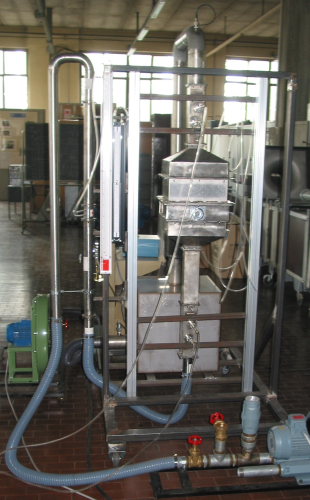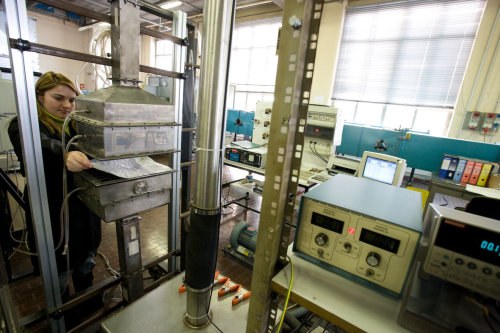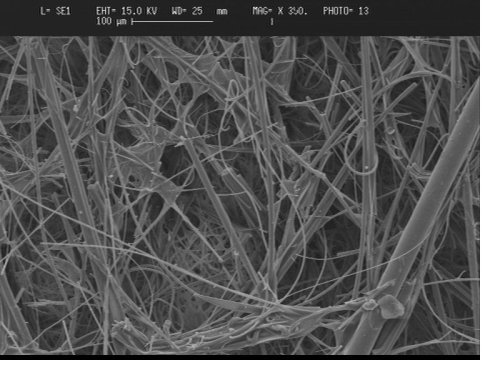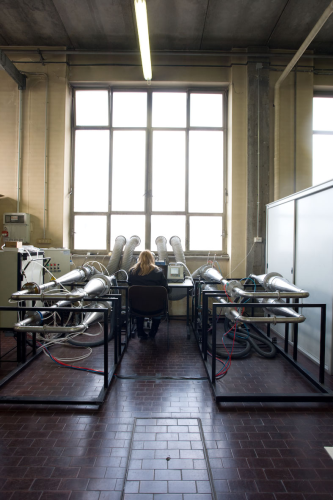



Generally accepted test methods exist for fabricated air filter cells in applications ranging from residential air conditioning to nuclear reactor safety systems. Some standards also exist for evaluating dust control equipment using cleanable fabrics and nonwovens in various forms. Test methods for the filtration media used in the filter elements of these systems have been slower to arrive. However, complete test methods for filtration media - analogous to ISO TS 21220 test for fabricated filter cells, for example - are now passing through the international consensus-standards process for both disposable and cleanable filter media.
There are valid reasons for the difference. Device manufacturers are reluctant to reveal the details of media used in their products. The exact mix of fibres, thickness, and other media physical properties are often crucial to the performance of a filtration product. The performance of a pleated filter is not easily predictable from the performance of flat sheet media. The performance of cleanable media is highly dependent on the geometric configuration of the separator device and its cleaning means.
Nevertheless, media test methods are needed for product quality control, and to assure design engineers and users that media will deliver promised performance under the environmental stresses of specific applications. Although some test results, required by government agencies for protecting public health, are openly available, other results can be kept under confidentiality agreements, to protect manufacturer trade secrets, while using rigorous, fully-defined test methods.
A survey of current standards relating to media testing shows that test methods for many media attributes have already been addressed by national and international standards-writing organisations. International standards for media could be built on this experience.
Test standards for filter media, like test standards for filtration devices, fall into two general categories - those intended for disposable filter cells, and those intended for devices having means for cleaning the filter media. The bulk of disposable filters are used in building HVAC systems, clean rooms and other applications having relatively benign environmental conditions. Cleanable media, however, are used in industrial processes, stack-gas cleaning and other applications which may require operation at high temperatures, wet or corrosive gas conditions, and much higher dust concentrations than the other group.
We identify a third category of gas filtration: specialty applications. We discuss these for a few categories: nuclear reactor and fuel-processing safety systems; grease arrestors; paint overspray capture; and mist eliminators and coalescers; metallic fiber media. Filter media for these applications may be identical with those used in the other two groups, but they require different test methods, and demonstration that the mechanical properties of the media can withstand the special environmental conditions of their applications.
Test standards for media in disposable air filters
Filter media in this group include those formed from fibrous materials, including natural or synthetic organic fibres and glass fibres. In their gross structures, these media have the form of nonwoven fabrics, wet-laid papers, or air-laid glass fibre mats spun from continuous fibres or blown from molten glass. Some membranes and open-cell foams also have fibrous structures. The solids content of these media is low, with the fibre volume typically less than 10 % of the volume of the media. These media range in thickness from a fraction of a millimetre to several centimetres.
Creating a test standard to cover such a variety of materials is not easy. Both national and international standards bodies, government agencies, technical societies and individual manufacturers have laboured to produce test standards for different attributes of this category of filters, and the media used in them. We discuss here only one standard, ISO/DIS 29463-3 ‘High efficiency filter and filter media for removing particles in air - Part 3: Testing flat sheet filter media’. This draft of a standard prepared for approval by the ISO (International Standards Organization) Technical Committee 142 (‘Cleaning equipment for air and other gases’) members defines a test method for flat sheet filter media used in the manufacture of high-efficiency filters. ‘High efficiency’ is defined here as 95% to 99.999995% at the Most Penetrating Particle Size (MPPS). The standard builds on earlier standards and method descriptions such as ASTM F778-88, IEST-RP-CC021.3, and EN 1822-3:2009.
Under ISO/DIS 29463-3, the test of particle penetration can be performed in either of two ways: using an aerosol having essentially a single particle diameter (a monodisperse aerosol) and condensation nucleus counters, or, using a polydisperse aerosol and light-scattering particle spectrometer/counters. Separate counters may be used, or a single counter may be switched from downstream to upstream. The table of contents of this draft standard shows the many details which such a standard must address. Every user will not agree with all the choices made by the standards writing committee. Indeed, we point out some weaknesses in the paragraphs below. Items covered in the draft include:
Procedures for obtaining test samples
Basically, the only requirement is that five samples be tested, and that they be ‘representative’. More statistically valid procedures which could reveal media non-uniformity are available in several standards for nonwovens, especially TAPPI 1007, which deals with glass fibre papers.
Media holder
Circular exposed area, 100 cm2. The holder illustration is obviously intended for tests on thin media with sufficient resistance to flatten the flow velocity profile over the exposed area. The straight cylinder sections at the media clamping flanges appear to be about 4 mm long. Longer straight sections would probably make the face velocity more uniform for low-resistance media, and would allow a reasonable space for static taps for resistance measurement. In addition, thicker media could be accommodated without distortion, using edge seals if necessary.
Aerosol sampling
An important feature of the standard is that the Most Penetrating Particle Size (MPPS) must be determined. MPPS is the particle diameter with the lowest measured efficiency. A detailed procedure to find it is given. The range of MPPS expected (approximately 0.01 μm to 0.8 μm) is small enough that isokinetic sampling was not deemed necessary. The only requirements for sampling lines are that they be conductive, grounded, clean, non-corrosive, and ‘short’. Under ANSI/ASHRAE 52.2, upstream and downstream sampling lines must be alike, which makes particle diameter bias the same for both. Loose specifications for sampling limit the usefulness of this ISO system to fine particle diameters. It should be possible to incorporate isokinetic sampling and minimal sampling-line particle losses into the standard.
Aerosol generation
Specified by diameter range only. The suggestion that DOP is an acceptable aerosol should be removed, since it is a known potentially carcinogen. Charge ‘neutralisation’ is required, but no details of type or intensity are given.
Aerosol particle counters
ISO/DIS 29463-2 ‘High Efficiency Filters and Filter Media for Removing Particles from Air - Part 2: Aerosol production, measuring equipment, particle counting statistics’ is referenced for specification of particle counters.
Data analysis
Statistical requirements are outlined, and ISO/DIS 29463-2 is referenced for detailed treatment of particle count statistics.
Reporting
Requirements are given, and a sample report presented.
ISO/DIS 29463-3 is a distinct advancement, but some sections illustrate the difficulties of creating complicated standards which require agreement by many people with individual experiences and interests.
Test standards for cleanable media in dust separation devices
Media used here include forms similar in geometry to disposable media, but with characteristics which make them suitable for harsher environmental conditions and the stresses of cleaning. These include organic, metallic and ceramic fibre media with random structures, often fabricated into cylindrical canisters or pleated structures. Woven fabrics, both of polymers and glass, are used in bag-houses. Because both the gross geometry of filter elements and media cleaning are important factors in performance of this type of dust separation equipment, earlier test methods were applicable to complete cylinders, pleated cartridges, or bags. Notable among these standards are ISO 5011 and JIS B9910.
In the 1980s, the group at the University of Karlsruhe developed test procedures for flat sheets of cleanable media, from which came VDI 3926. This standard, which had been formalised by 1992, ignores the effects of gross dust collector geometry, dusts, and cleaning techniques (shaking, reversing-flow and compressed-air pulses) in favour of a strictly defined flat sheet procedure. It is, therefore, a comparative procedure for media, and cannot, and does not pretend to replace tests on complete dust control devices with the actual aerosols and gas conditions they face in industrial situations. There is, however, a high-temperature version of the test system. ASTM D6830 (published in 2002) is very similar to VDI 3926.
The experts, recognising the difficulties of writing a standard which recreates industrial conditions, have chosen to create ISO/DIS 11057 ‘Air quality - Test method for filtration characterisation of cleanable filter media’, which is clearly derivative from VDI 3926. This draft standard was submitted to ISO member organisations for public enquiry in late 2009. Some test requirements (e.g. flow measurement) parallel ISO/DIS 29463-3; we describe here some which are unique to ISO/DIS 11057.
Test system
The test duct and instrumentation, including the holder for the test filter sample and the cleaning mechanism, are specified in great detail. Substantial automation is required for the instrumentation. Deviations from the specified system are allowed, but the user of non-conforming systems must show tests made on three filter media which compare with tests made on the specified system within specified error bounds.
Test dust
The dust required for testing is Pural NF, alumina monohydrate in powder form with an approximate mass mean diameter of 4.5 µm and an approximate diameter range provided by the manufacturer. This is a practical solution, but hazardous, since one cannot always rely on a single manufacturer, and the quality controls are only vaguely defined. The dust feeder is not defined, nor are particle diameter size distributions specified for the test dust as a bulk powder or dispersed in the airstream.
Upstream dust concentration
This is specified at 5 g/m3 ± 7%. The stability of the concentration is continuously monitored by a photometric system. Concentration and dust feeder conditions are set by a preliminary test measuring the weight gain of a filter sample in the media holder. There is also an implication that concentration can be determined by the weight change of the entire dust feeder during the test combined with the duct flow measurement, but this procedure is not detailed.
Downstream dust concentration
This is determined by weighing a filter located downstream of the test sample holder. The downstream filter filters the entire flow, and must have the MPPS efficiency of at least 99.95% when measured by EN 1822-3, ie: using a considerably finer aerosol than Pural NF.
Gas conditions and flow distribution
Temperature and humidity ranges are specified. The air face velocity distribution over the filter media sample is allowed to be whatever aerodynamics provides, and it is assumed that “… a uniform dust concentration is attained over the filter face”. The assumption of uniform dust concentration seems unwarranted, but it is immaterial; the standard simply compares media performance under the defined conditions.
Cleaning means
A specific nozzle design and compressed-air pulse form are required for the reverse air flow cleaning pulse. The form and magnitude of the pulse must be demonstrated at least once a year, using a high-speed pressure transducer. This is perhaps the most precisely defined element of the standard, indicative of the importance of cleaning patterns on performance results.
Cleaning cycles and characterisation of residual dust cake
The compressed-air cleaning pulse is activated whenever the pressure drop across the media sample reaches 1000 Pa, or for one test set, 1800 Pa. A series of five test phases is required; the details of these are too extensive to present here. Residual conditions - the mass of dust remaining on the filter sample and the pressure drop across it after a set of cleaning cycles are measured during all five phases, and the downstream average dust concentration is measured at the ends of three phases.
Data recording and analysis
The automation of pressure drop measurement and the inclusion of a computer in the system means that the pattern of pressure drop over many cycles of each test phase can be recorded and included in a report. Residual dust mass data must be entered by hand. No special attention to statistics is required, because no particle counts are involved in this test method.
Reporting
Requirements are given, and sample reports presented.
Test standards for media in speciality applications
Nuclear safety systems
Governments worldwide regulate the design and testing of nuclear safety systems. A loss-of-coolant accident will expose reactor safety systems to steam and free water; particulate filters in these systems are required to demonstrate their ability to survive such exposure. Examples of such test procedures, promulgated by the US Nuclear Regulatory Commission, are available at www.nrc.gov/reading-rm/doc-collections/nuregs.
Grease arrestors for kitchen hoods
These systems face a heavy concentration of an aerosol which easily plugs filters, and is also highly flammable and odourous. Control of the aerosol usually requires a combination of a louvre-type aerodynamic collector and downstream fibrous (expanded metal) filters. One particle-efficiency testing standard is described by Schrock et al. ‘A New Standard Method of Test for Determining the Grease Particulate Removal Efficiency of Filter Systems for Kitchen Ventilation’ (ASHRAE Transactions, vol. 112, p. 583-590, 2006); both efficiency and flammability tests are given, for example, in Underwriters’ Laboratories UL 1046, obtainable at http://ulstandardsinfonet.ul.com.
Paint overspray collectors
Like grease, paint sprays plug filter media rapidly, and are flammable. They cannot be removed from media, however, and generation and detection of test aerosols is quite different in the two cases. One test standard for paint overspray filters is available at www.epa.gov/ttn/emc/proposed/m-319.pdf. It does not use actual paint spray aerosols, which would wreak havoc with users’ test ducts, but uses what is essentially EN 1822-5 with a (dry) KCl aerosol and then with a (liquid) oleic acid aerosol.
Demisters and mist coalescers
Fibrous droplet capture filters (demisters) are a necessary part of some chemical processes. Similar filters are often incorporated in compressed air supplies, capturing condensed water vapour. Test procedures have been developed by manufacturers and organisations such as the American Petroleum Institute [search API 1581, Pall GAS-4300b for discussions]. Because of the importance of the diameter and surface properties of liquid droplets and the fibres used to capture them, actual process streams are often tested.
High-temperature metallic fibre cartridge filters
Metallic fibrous filter media are available with fibre diameters as small as 0.5 µm, and in metals like stainless steel, capable of withstanding high temperatures and some corrosive atmospheres. Even at HEPA filter efficiencies, these media can be cleaned. Developing standard methods for testing these under service conditions might be desirable. It would be difficult, but not impossible.
Prospects for international standards
ISO has only begun its task of establishing media test standards. All sections of ISO/DIS 29463 and ISO/DIS 11057 remain to be finalised. At this time, ISO TC 142 Working Group 3 ‘General ventilation filters’ has initiated the new project NP 14086, which will seek to produce a standard to test performance of media used in general-ventilation filters. It would therefore be intended for media less efficient than the EPA/HEPA/ULPA media evaluated by ISO/DIS 29463-3. Whether the scope of the standard would include a dust holding capacity test, and what media physical attributes to include, has not been decided.





